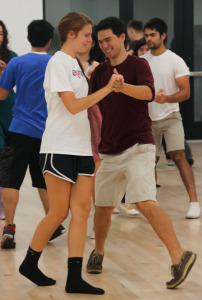
One of the most popular series of classes offered at Stanford is social dance, which gives students the opportunity to learn common partner dances and interact with students from a variety of fields in a fun and relaxed environment. Richard Powers, a social dance instructor, has seen the program grow and change drastically since he began teaching 22 years ago.
“I switched it to more non-competitive social dance, including today’s music,” Powers said, explaining how the classes used to center around competitive ballroom dancing.
The changes certainly paid off; Social Dance 1, the introductory class, is incredibly popular and almost always has a waiting list. Most students hear about the class by word of mouth. Powers said that the most common students he teaches are freshmen, who heard rave reviews from upperclassmen and seniors who had taken it during last spring quarter after hearing about it for the past four years.
“My freshman year here, everyone was talking about it, ‘Oh, you have to take social dance once when you’re at Stanford, it’s one of those classes, up in the realm of 106A,’” said Melissa Carvell B.A. ’13, who now works as a teaching assistant.
Some students, like Carvell, who danced ballet, tap and jazz when she was younger, have dance experience prior to coming to Stanford and see social dance as a way to continue with the activity.
“I thought it was going to be a space where I could continue what I had done in high school,” said Andrea Hale ’15, another TA for the class, regarding why she signed up for Social Dance 1 in freshman year.
For many other students, however, Social Dance 1 is their first exposure to dance. Carvell said that the class is very popular with engineering and computer science majors or other students who want to take a class with a more social element.
“You see people going from being really shy in the first class to their second, third, fourth class being very outgoing, ready to talk to people and just more comfortable with themselves,” Carvell said.
Beginners can take Social Dance 1 and then graduate to level 2 or 3. Advanced dancers can even take classes like History of Waltz. In Social Dance 1, students can learn different types of ballroom like the waltz, tango, salsa and cha-cha. Social Dance 2 and 3 each focus on a more specialized type of dance.
The format of the classes, where students switch partners every few minutes, fosters a friendly and welcoming community. Undergraduate and graduate students alike take the classes, and from Carvell’s and Hale’s perspectives as TAs there is no discernible divide between different age groups.
Nick Enge B.S. ’09 M.S. ’11, also an active participant in the dance community at Stanford, resisted taking a class throughout his undergraduate career, fearing it would be too similar to the dancing he had done during his years in musical theater. Eventually, a friend convinced him to take Social Dance 1 as a grad student.
“I went the first day and just loved it the first step that I took,” Enge said, adding that by now he has taken “almost all of [the classes offered],” and some classes multiple times.
Enge’s experience is shared by many students who unexpectedly find themselves passionate about an activity they had never tried before.
“Many people discover a great fondness for social dancing,” Powers said. “To the point that a large number choose to find a job in the Bay Area instead of elsewhere so that they can keep on dancing these dances with their friends.”
Both Enge and Carvell have expanded their involvement in social dance beyond the classes offered at Stanford. They, along with several other students who found their passion in social dance, teach and DJ classes in the Bay Area such as Friday Night Waltz, which is offered every Friday in downtown Palo Alto. Enge and Carvell are planning to start teaching a class called Tuesday Night Salsa as well.
“There are a bunch of us [at Stanford] who get really into it and then decide we want to do as much as we possibly can,” Enge said.
According to Powers, San Francisco has a prominent social dance scene as well, with many clubs specializing in dances like waltz, salsa and swing. It is not the only American city with a large social dance culture, but Powers said that it is unique in the atmosphere created by the teachers.
“Instead of vying to be the only one, the top dog, I tend to see the teachers in the area supporting others,” he explained. This attitude creates a friendlier and less competitive atmosphere around social dance, unlike in many other cities.
The social dance scene on Stanford campus reflects the cooperative nature of the greater Bay Area.
“[Stanford has] a pretty strong community,” Hale said. “People are very welcoming.”
Contact Sarah Wishingrad at swishing ‘at’ stanford.edu.